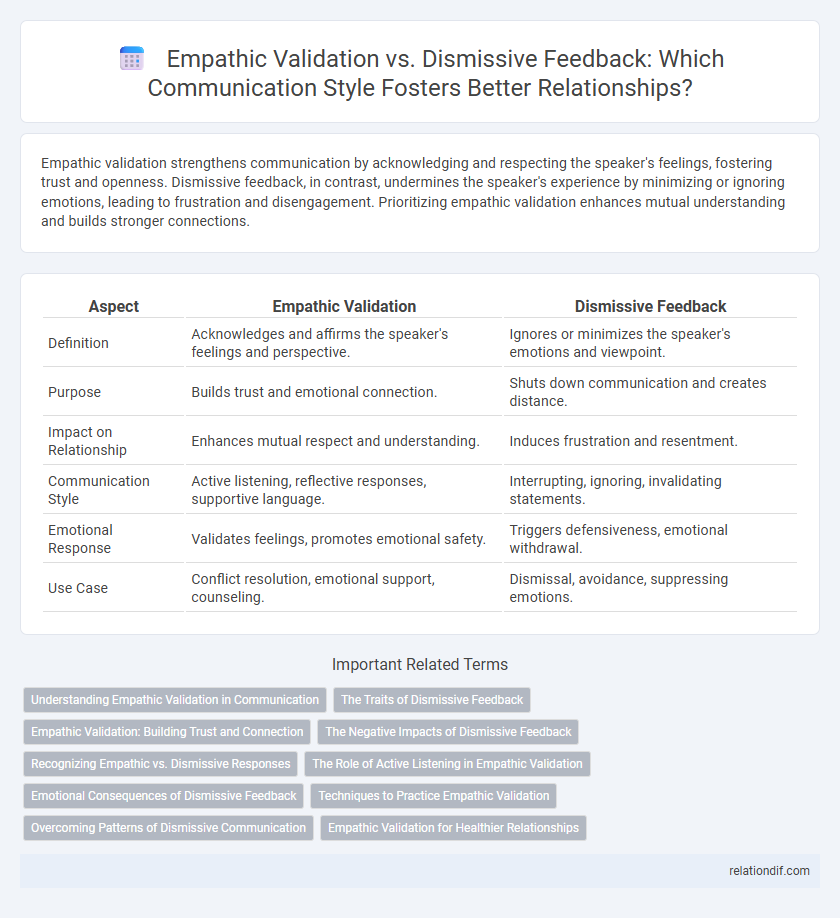Empathic validation strengthens communication by acknowledging and respecting the speaker's feelings, fostering trust and openness. Dismissive feedback, in contrast, undermines the speaker's experience by minimizing or ignoring emotions, leading to frustration and disengagement. Prioritizing empathic validation enhances mutual understanding and builds stronger connections.
Table of Comparison
| Aspect | Empathic Validation | Dismissive Feedback |
|---|---|---|
| Definition | Acknowledges and affirms the speaker's feelings and perspective. | Ignores or minimizes the speaker's emotions and viewpoint. |
| Purpose | Builds trust and emotional connection. | Shuts down communication and creates distance. |
| Impact on Relationship | Enhances mutual respect and understanding. | Induces frustration and resentment. |
| Communication Style | Active listening, reflective responses, supportive language. | Interrupting, ignoring, invalidating statements. |
| Emotional Response | Validates feelings, promotes emotional safety. | Triggers defensiveness, emotional withdrawal. |
| Use Case | Conflict resolution, emotional support, counseling. | Dismissal, avoidance, suppressing emotions. |
Understanding Empathic Validation in Communication
Empathic validation in communication involves recognizing and affirming another person's emotions and experiences, enhancing mutual understanding and trust. This approach fosters open dialogue by creating a safe environment where individuals feel heard and respected, which can improve relational dynamics and emotional connection. Unlike dismissive feedback, which disregards or minimizes feelings, empathic validation supports emotional intelligence and effective interpersonal communication.
The Traits of Dismissive Feedback
Dismissive feedback is characterized by minimization of the speaker's feelings, lack of acknowledgment, and invalidation of their perspective. It often includes interruptions, ignoring emotional cues, and offering unsolicited advice instead of understanding. Such feedback hampers trust, reduces openness, and damages communication effectiveness by creating emotional distance.
Empathic Validation: Building Trust and Connection
Empathic validation strengthens communication by acknowledging and respecting others' feelings, fostering a foundation of trust and emotional safety. This approach encourages openness, reduces defensiveness, and promotes deeper connections in personal and professional relationships. Prioritizing empathic validation over dismissive feedback enhances mutual understanding and supports collaborative problem-solving.
The Negative Impacts of Dismissive Feedback
Dismissive feedback undermines emotional trust by invalidating individuals' feelings, leading to increased anxiety and decreased self-esteem. This type of response disrupts effective communication, causing frustration and withdrawal from open dialogue. Persistent dismissiveness fosters a hostile environment where misunderstandings escalate and collaboration deteriorates.
Recognizing Empathic vs. Dismissive Responses
Recognizing empathic responses involves identifying language that acknowledges and validates emotions, such as reflective listening and affirmations that demonstrate understanding. In contrast, dismissive feedback often includes minimizing feelings, interrupting, or redirecting the conversation away from the speaker's concerns, signaling a lack of emotional attunement. Effective communication requires sensitivity to these distinctions to foster trust and emotional safety in interpersonal interactions.
The Role of Active Listening in Empathic Validation
Active listening plays a crucial role in empathic validation by fully engaging with the speaker's emotions and perspectives, fostering trust and understanding. It involves attentive body language, reflective responses, and withholding judgment to accurately capture the speaker's feelings. This approach significantly contrasts dismissive feedback, which neglects emotional cues and undermines effective communication.
Emotional Consequences of Dismissive Feedback
Dismissive feedback often triggers feelings of invalidation, frustration, and decreased self-esteem, harming emotional well-being. It can lead to withdrawal, reduced trust, and impaired communication in relationships. Recognizing emotional consequences of dismissive feedback is crucial for fostering empathetic, supportive interactions.
Techniques to Practice Empathic Validation
Empathic validation involves actively listening, acknowledging emotions, and reflecting feelings back to the speaker to foster understanding and trust. Techniques include using open-ended questions, maintaining nonverbal cues like eye contact and nodding, and summarizing the speaker's perspective to confirm comprehension. Practicing these strategies enhances emotional connection and minimizes miscommunication, contrasting sharply with dismissive feedback which invalidates feelings and undermines dialogue.
Overcoming Patterns of Dismissive Communication
Overcoming patterns of dismissive communication requires actively practicing empathic validation, which acknowledges and respects the speaker's emotions and perspectives. Dismissive feedback often invalidates experiences, leading to breakdowns in trust and openness, whereas empathic validation fosters connection and understanding. Consistent use of empathic language and reflective listening creates a supportive communication environment that reduces defensiveness and encourages authentic dialogue.
Empathic Validation for Healthier Relationships
Empathic validation involves acknowledging and understanding another person's feelings, which fosters trust and emotional safety in relationships. Healthier relationships emerge when partners feel heard and respected, promoting open communication and reducing conflicts. This approach contrasts with dismissive feedback, which can lead to misunderstandings and emotional distance.
Empathic validation vs Dismissive feedback Infographic

 relationdif.com
relationdif.com